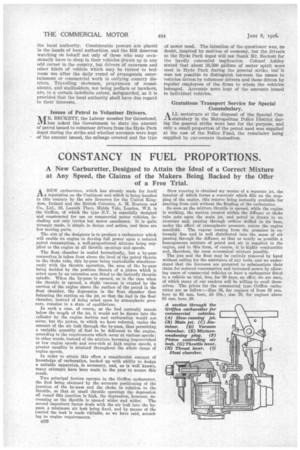CONSTANCY IN FUEL PROPORTIONS.
Page 10

If you've noticed an error in this article please click here to report it so we can fix it.
A New Carburetter, Designed to Attain the Ideal of a Correct Mixture at Any Speed, the Claims of the Makers Being Backed by the Offer of a Free Trial.
ANEW carburetter, which has already made for itself a reputation on the Continent and which is being handled in this country by the sole licensees for the United Kingdom, Ireland and the British Colonies, A. M. Beatson and Co., Ltd., 10, Lanark Place, Maida Vale, London, WS, is the Griffon, of which the type E.V. is especially designed and constructed for use on commercial motor vehicles, including not only lorries but motor omnibuses. It is quite strongly made, is simple in design and action, and there are few moving parts.
The aim of the designers is to produce a carburetter which will enable an engine to develop full power upon a reduced petrol consumption, a well-proportioned mixture being supplied to the engine at all throttle openings and speeds.
The float chamber is sealed hermetically, but a by-pass connection is taken from above the level of the petrol therein to the choke tube, this by-pass being controllable simultaneously with the throttle operation, the area of the by-pass being decided by the position therein of a piston which is acted upon by an extension arm fitted to the butterfly throttle spindle. When the by-pass is opened, as is the case when the throttle is opened, a slight vacuum is created by the suction of the engine above the surface of the petrol in the float chamber, the depression in the float chamber then balancing the suction on the jet, so that the fuel in the float chamber, instead of being acted upon by atmospheric pressure, remains in a state of equilibrium.
In such a case, of course, as the fuel normally stands below the mouth of the jet, it would not be drawn into the cylinder by the engine suction and carburation would not occur, but the piston, to which we have referred, varies the amount of the air leak through the by-pass, thus permitting a variable quantity of fuel to be delivered to the engine, according to the requirements which occur at various speeds; in other words, instead of the mixture becoming impoverished at low engine speeds and over-rich at high engine speeds, a greater equality is attained throughout the whole range of engine speeds.
In order to attain this effect a considerable amount of knowledge of carburation, backed up with ability to design a suitable apparatus, is necessary, and, as is well known, many attempts have been made in the past to secure this result.
Two principal factors operate in the Griffon carburetter, the first being obtained by the accurate positioning of the junction of the by-pass and the choke in relation to the throttle, so that at small throttle openings the depression all round this junction is high, the depression, however, decreasing as the throttle is opened wider and wider. The second important factor deals with the air leak into the bypass, a minimum air leak being fixed, and by means of the control the leak is made 1i-triable, as we have said, according to engine requirements.
B26
Slow running is obtained my means of a separate jet, the interior of which forms a reservoir which fills on the stopping of the engine, this reserve being instantly available for starting from cold without the flooding of the carburetter.
So soon as the mixture throttle is opened, while the engine is working, the suction created within the diffuser or choke tube acts upon the main jet, and petrol is drawn to an atomizer and, passing through orifices drilled in its base, under the effect of atmospheric pressure, enters the engine manifold. The vapour issuing from the atomizer is extremely' fine and is well distributed into the mass of air passing through the diffuser, so that as nearly as possible a homogeneous mixture of petrol and air is supplied to the engine, and in this form, of course, it is highly combustible and, therefore, the most economical mixture possible.
The jets and the float may be entirely removed by hand without calling for the adsistance of any tools, and we understand that the licensees are prepared to substantiate their claim for reduced consumption and increased power by allowing users of commeTcial vehicles to have a carbuetter fittedto a vehicle ontrial, free, for 30 days, an offer, we are sure, of which many of our readers will be willing to avail themselves. The prices for the commercial type Griffon carburetter are as follow :—Size 36, for engines of from 85 mm. bore to 95 mm. bore, £8 10s.; size 38, for engines above 95 mm. bore. £9.




























